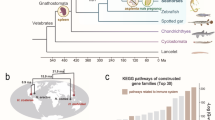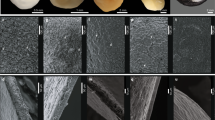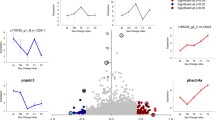Abstract
Vertebrates have developed various modes of reproduction, some of which are found in Teleosts. Over 300 species of the Syngnathidae (seahorses, pipefishes and seadragons) exhibit male pregnancies; the males have specialized brood pouches that provide immune protection, nourishment, and oxygen regulation. Chemokines play a vital role at the mammalian maternal–fetal interface; however, their functions in fish reproduction are unclear. This study revealed the evolutionary traits and potential functions of chemokine genes in 22 oviparous, ovoviviparous, and viviparous fish species through comparative genomic analyses. Our results showed that chemokine gene copy numbers and evolutionary rates vary among species with different modes of reproduction. Syngnathidae lost cxcl13 and cxcr5, which are involved in key receptor–ligand pairs for lymphoid organ development. Notably, Syngnathidae have site-specific mutations in cxcl12b and ccl44, suggesting immune function during gestation. Moreover, transcriptome analysis revealed that chemokine gene expression varies among Syngnathidae species with different types of brood pouches, suggesting adaptive variations in chemokine functions among seahorses and their relatives. Furthermore, challenge experiments on seahorse brood pouches revealed a joint immune function of chemokine genes during male pregnancy. This study provides insights into the evolutionary diversity of chemokine genes associated with different reproductive modes in fish.






Similar content being viewed by others
Data availability
The authors declare that all data supporting the findings of this study are available within the article and its supplementary files.
References
Ansel KM, Ngo VN, Hyman PL, Luther SA, Förster R, Sedgwick JD, Browning JL, Lipp M, Cyster JG (2000) A chemokine-driven positive feedback loop organizes lymphoid follicles. Nature 406:309–314
Arenberg DA, Kunkel SL, Shanafelt A, Strieter RM (1997) In vitro and in vivo systems to assess role of CXC chemokines in regulation of angiogenesis. Meth Enzymol 288:190–220
Ashley RL, Runyan CL, Maestas MM, Trigo E, Silver G (2021) Inhibition of the CXC motif chemokine 12 (CXCL12) and its receptor CXCR4 reduces utero-placental expression of the VEGF system and increases utero-placental autophagy. Front Vet Sci 8:650–687
Bird S, Tafalla C (2015) Teleost chemokines and their receptors. Biology 4:756–784
Bonecchi R, Mantovani A, Jaillon S (2022) Chemokines as regulators of neutrophils: focus on tumors, therapeutic targeting, and immunotherapy. Cancers 14:680
Carcupino M (2002) Functional significance of the male brood pouch in the reproductive strategies of pipefishes and seahorses: a morphological and ultrastructural comparative study on three anatomically different pouches. J Fish Biol 61:1465–1480
Chang RQ, Zhou WJ, Li DJ, Li MQ (2020) Innate lymphoid cells at the maternal-fetal interface in human pregnancy. Int J Biol Sci 16:957–969
Chen L, Qiu Q, Jiang Y, Wang K, Lin ZS, Li ZP, Bibi F, Yang YZ, Wang JH, Nie WH, Su WT, Liu GC, Li QY, Fu W, Pan X, Liu C, Yang J, Zhang C, Yin Y, Wang Y et al (2019) Large-scale ruminant genome sequencing provides insights into their evolution and distinct traits. Science 364:eaav6202
Du MR, Wang SC, Li DJ (2014) The integrative roles of chemokines at the maternal–fetal interface in early pregnancy. Cell Mol Immunol 11:438–448
Fu Q, Yang YJ, Li C, Zeng QF, Zhou T, Li N, Liu Y, Liu SK, Liu ZJ (2017) The CC and CXC chemokine receptors in channel catfish (Ictalurus punctatus) and their involvement in disease and hypoxia responses. Dev Comp Immunol 77:241–251
Fu Q, Hu J, Zhang P, Li YQ, Zhao SC, Cao M, Yang N, Li C (2022a) CC and CXC chemokines in turbot (Scophthalmus maximus L.): identification, evolutionary analyses, and expression profiling after Aeromonas salmonicida infection. Fish Shellfish Immunol 127:82–98
Fu Q, Li YQ, Zhao SC, Cao M, Yang N, Huo HJ, Yan X, Cao Z, Zhang P, Li C (2022b) CC chemokines and their receptors in black rockfish (Sebastes schlegelii): characterization, evolutionary analysis, and expression patterns after Aeromonas salmonicida infection. Aquaculture 546:737377
Gao W, Sun YB, Zhou WW, **ong ZJ, Chen L, Li H, Fu TT, Xu K, Xu W, Ma L, Chen YJ, **ang XY, Zhou L, Zeng T, Zhang S, ** JQ, Chen HM, Zhang G, Hillis DM, Ji X et al (2019) Genomic and transcriptomic investigations of the evolutionary transition from oviparity to viviparity. Proc Natl Acad Sci USA 116:3646–3655
Gao A, Yan FF, Zhou EX, Wu LT, Li L, Chen JL, Lei Y, Ye JM (2020) Molecular characterization and expression analysis of chemokine (CXCL12) from Nile tilapia (Oreochromis niloticus). Fish Shellfish Immunol 104:314–323
Glasauer SMK, Neuhauss SCF (2014) Whole-genome duplication in teleost fishes and its evolutionary consequences. Mol Genet Genom 289:1045–1060
Gomez-Lopez N, Guilbert LJ, Olson DM (2010) Invasion of the leukocytes into the fetal-maternal interface during pregnancy. J Leukoc Biol 88:625–633
Gouwy M, Schiraldi M, Struyf S, Van Damme J, Uguccioni M (2012) Possible mechanisms involved in chemokine synergy fine tuning the inflammatory response. Immunol Lett 145:10–14
Hannan NJ, Salamonsen LA (2007) Role of chemokines in the endometrium and in embryo implantation. Curr Opin Obstet Gynecol 19:266–272
Harada A, Shiota R, Okubo R, Yorifuji M, Sogabe A, Motomura H, Hiroi J, Yasumasu S, Kawaguchi M (2022) Brood pouch evolution in pipefish and seahorse based on histological observation. Placenta 120:88–96
Harrison MR, Bussmann J, Huang Y, Zhao L, Osorio A, Burns CG, Burns CE, Sucov HM, Siekmann AF, Lien CL (2015) Chemokine-guided angiogenesis directs coronary vasculature formation in zebrafish. Dev Cell 33:442–454
Helmstetter AJ, Papadopulos AST, Igea J, Van Dooren TJM, Leroi AM, Savolainen V (2016) Viviparity stimulates diversification in an order of fish. Nat Commun 7:11271
Jiang H, Li CY, Zhang B, Wu YL, Lin Q (2022) Roles of interleukins in antibacterial immune defense of the brood pouch in the lined seahorse Hippocampus erectus. J Oceanol Limnol 40:235–244
Jovanović M, Stefanoska I, Radojčić L, Vićovac L (2010) Interleukin-8 (CXCL8) stimulates trophoblast cell migration and invasion by increasing levels of matrix metalloproteinase (MMP)2 and MMP9 and integrins α5 and β1. Reproduction 139:789–798
Katoh K, Misawa K, Kuma K-I, Miyata T (2002) MAFFT: a novel method for rapid multiple sequence alignment based on fast Fourier transform. Nucleic Acids Res 30:3059–3066
Kawaguchi M, Nakano Y, Kawahara-Miki R, Inokuchi M, Yorifuji M, Okubo R, Nagasawa T, Hiroi J, Kono T, Kaneko T (2016) An evolutionary insight into the hatching strategies of pipefish and seahorse embryos. J Exp Zool B Mol Dev Evol 326:125–135
Kawaguchi M, Okubo R, Harada A, Miyasaka K, Takada K, Hiroi J, Yasumasu S (2017) Morphology of brood pouch formation in the pot-bellied seahorse Hippocampus abdominalis. Zool Lett 3:19
Keane MP, Arenberg DA, Moore BB, Addison CL, Strieter RM (1998) CXC chemokines and angiogenesis/angiostasis. Proc Assoc Am Physicians 110:288–296
Keilwagen J, Hartung F, Paulini M, Twardziok SO, Grau J (2018) Combining RNA-seq data and homology-based gene prediction for plants, animals and fungi. BMC Bioinformatics 19:189
Keller IS, Salzburger W, Roth O (2017) Parental investment matters for maternal and offspring immune defense in the mouthbrooding cichlid Astatotilapia burtoni. BMC Evol Biol 17:264
Kitazawa J, Kimura F, Nakamura A, Morimune A, Takahashi A, Takashima A, Amano T, Tsuji S, Kaku S, Kasahara K (2020) Endometrial immunity for embryo implantation and pregnancy establishment. Tohoku J Exp Med 250:49–60
Kumar A, Kumar S, Dinda AK, Luthra K (2004) Differential expression of CXCR4 receptor in early and term human placenta. Placenta 25:347–351
Li CY, Li YX, Qin G, Chen ZL, Qu M, Zhang B, Han X, Wang X, Qian PY, Lin Q (2020) Regulatory role of retinoic acid in male pregnancy of the seahorse. Innovation 1:100052
Lin Q, Fan SH, Zhang YH, Xu M, Zhang HX, Yang YL, Lee AP, Woltering JM, Ravi V, Gunter HM, Luo W, Gao ZX, Lim ZW, Qin G, Schneider RF, Wang X, **ong PW, Li G, Wang K, Min JM et al (2016) The seahorse genome and the evolution of its specialized morphology. Nature 540:395–399
Lin Z, Chen L, Chen X, Zhong Y, Yang Y, **a W, Liu C, Zhu W, Wang H, Yan B, Yang Y, Liu X, Sternang Kvie K, Røed KH, Wang K, **ao W, Wei H, Li G, Heller R, Gilbert MTP et al (2019) Biological adaptations in the Arctic cervid, the reindeer (Rangifer tarandus). Science 364:eaav6312
Liu XX, Kang LS, Liu W, Lou B, Wu CW, Jiang LH (2017) Molecular characterization and expression analysis of the large yellow croaker (Larimichthys crocea) chemokine receptors CXCR2, CXCR3, and CXCR4 after bacterial and poly I: C challenge. Fish Shellfish Immunol 70:228–239
Liu YL, Wu YL, Qin G, Chen Y, Wang X, Lin Q (2021) Bioaccumulation and reproductive toxicity of bisphenol A in male-pregnant seahorse (Hippocampus erectus) at environmentally relevant concentrations. Sci Total Environ 753:141805
Lodé T (2012) Oviparity or viviparity? That is the question. Reprod Biol 12:259–264
Lu J, Chatterjee M, Schmid H, Beck S, Gawaz M (2016) CXCL14 as an emerging immune and inflammatory modulator. J Inflamm 13:1
Lu WJ, Zhou L, Gao FX, Zhou YL, Li Z, Zhang XJ, Wang Y, Gui JF (2020) Dynamic and differential expression of duplicated Cxcr4/Cxcl12 genes facilitates antiviral response in hexaploid gibel carp. Front Immunol 11:2176
Marchesi F, Martin AP, Thirunarayanan N, Devany E, Mayer L, Grisotto MG, Furtado GC, Lira SA (2009) CXCL13 expression in the gut promotes accumulation of IL-22-producing lymphoid tissue-inducer cells, and formation of isolated lymphoid follicles. Mucosal Immunol 2:486–494
Matsunaga T, Rahman A (1998) What brought the adaptive immune system to vertebrates?–The jaw hypothesis and the seahorse. Immunol Rev 166:177–186
Mörbe UM, Jørgensen PB, Fenton TM, von Burg N, Riis LB, Spencer J, Agace WW (2021) Human gut-associated lymphoid tissues (GALT); diversity, structure, and function. Mucosal Immunol 14:793–802
Nomiyama H, Osada N, Yoshie O (2013) Systematic classification of vertebrate chemokines based on conserved synteny and evolutionary history. Genes Cells 18:1–16
Packham IM, Gray C, Heath PR, Hellewell PG, Ingham PW, Crossman DC, Milo M, Chico TJ (2009) Microarray profiling reveals CXCR4a is downregulated by blood flow in vivo and mediates collateral formation in zebrafish embryos. Physiol Genom 38:319–327
Park C, Bae H, Bazer FW, Song G, Lim W (2019) Activation of CCL20 and its receptor CCR6 promotes endometrium preparation for implantation and placenta development during the early pregnancy period in pigs. Dev Comp Immunol 92:35–42
Parker J, Dubin A, Schneider R, Wagner KS, Jentoft S, Böhne A, Bayer T, Roth O (2023) Immunological tolerance in the evolution of male pregnancy. Mol Ecol 32:819–841
Paulesu L, Bigliardi E, Paccagnini E, Ietta F, Cateni C, Guillaume CP, Heulin B (2005) Cytokines in the oviparity/viviparity transition: evidence of the interleukin-1 system in a species with reproductive bimodality, the lizard Lacerta vivipara. Evol Dev 7:282–288
Peatman E, Liu Z (2007) Evolution of CC chemokines in teleost fish: a case study in gene duplication and implications for immune diversity. Immunogenetics 59:613–623
Pertea M, Kim D, Pertea GM, Leek JT, Salzberg SL (2016) Transcript-level expression analysis of RNA-seq experiments with HISAT, StringTie and Ballgown. Nat Protoc 11:1650–1667
Peterson LS, Stelzer IA, Tsai AS, Ghaemi MS, Han X, Ando K, Winn VD, Martinez NR, Contrepois K, Moufarrej MN, Quake S, Relman DA, Snyder MP, Shaw GM, Stevenson DK, Wong RJ, Arck P, Angst MS, Aghaeepour N, Gaudilliere B (2020) Multiomic immune clockworks of pregnancy. Semin Immunol 42:397–412
Qu M, Liu YL, Zhang YH, Wan SM, Ravi V, Qin G, Jiang H, Wang X, Zhang HX, Zhang B, Gao ZX, Huysseune A, Zhang Z, Zhang H, Chen ZL, Yu HY, Wu YL, Tang L, Li CY, Zhong J et al (2021) Seadragon genome analysis provides insights into its phenotype and sex determination locus. Sci Adv 7:eabg5196
Roth O, Solbakken MH, Torresen OK, Bayer T, Matschiner M, Baalsrud HT, Hoff SNK, Brieuc MSO, Haase D, Hanel R, Reusch TBH, Jentoft S (2020) Evolution of male pregnancy associated with remodeling of canonical vertebrate immunity in seahorses and pipefishes. Proc Natl Acad Sci USA 117:9431–9439
Sommer F, Torraca V, Meijer AH (2020) Chemokine receptors and phagocyte biology in zebrafish. Front Immunol 11:325
Stamatakis A (2014) RAxML version 8: a tool for phylogenetic analysis and post-analysis of large phylogenies. Bioinformatics 30:1312–1313
Star B, Nederbragt AJ, Jentoft S, Grimholt U, Malmstrøm M, Gregers TF, Rounge TB, Paulsen J, Solbakken MH, Sharma A, Wetten OF, Lanzén A, Winer R, Knight J, Vogel J-H, Aken B, Andersen Ø, Lagesen K, Tooming-Klunderud A, Edvardsen RB et al (2011) The genome sequence of Atlantic cod reveals a unique immune system. Nature 477:207–210
Turner LM, Hoekstra HE (2008) Causes and consequences of the evolution of reproductive proteins. Int J Dev Biol 52:769–780
Velaga S, Herbrand H, Friedrichsen M, Jiong T, Dorsch M, Hoffmann MW, Förster R, Pabst O (2009) Chemokine receptor CXCR5 supports solitary intestinal lymphoid tissue formation, B cell homing, and induction of intestinal IgA responses. J Immunol 182:2610–2619
Whittington CM, Friesen CR (2020) The evolution and physiology of male pregnancy in syngnathid fishes. Biol Rev Camb Philos Soc 95:1252–1272
Whittington CM, Griffith OW, Qi W, Thompson MB, Wilson AB (2015) Seahorse brood pouch transcriptome reveals common genes associated with vertebrate pregnancy. Mol Biol Evol 32:3114–3131
Wickler W (1962) ‘Egg-dummies’ as natural releasers in mouth-breeding cichlids. Nature 194:1092–1093
Wolf YI, Novichkov PS, Karev GP, Koonin EV, Lipman DJ (2009) The universal distribution of evolutionary rates of genes and distinct characteristics of eukaryotic genes of different apparent ages. Proc Natl Acad Sci USA 106:7273–7280
Wu YL, Liu YL, Zhang HX, Wang X, Lin Q (2021) Expression patterns of alpha-2 macroglobulin reveal potential immune functions in brood pouch of the lined seahorse Hippocampus erectus. Aquaculture 533:736064
**ao WH, Chen ZL, Zhang YH, Wu YL, Jiang H, Zhang HX, Qu M, Lin Q, Qin G (2022) Hepcidin gene co-option balancing paternal immune protection and male pregnancy. Front Immunol 13:884417
Zhang YH, Ravi V, Qin G, Dai H, Zhang HX, Han FM, Wang X, Liu YH, Yin JP, Huang LM, Venkatesh B, Lin Q (2020) Comparative genomics reveal shared genomic changes in syngnathid fishes and signatures of genetic convergence with placental mammals. Natl Sci Rev 7:964–977
Zheng Z, Chen HY, Zhu SR, Hu YJ (2021) CXCR4/CXCR7 protein expression levels in placentas of patients with preeclampsia. Med Sci Monit 27:e931192
Złotkowska A, Andronowska A (2019) Chemokines as the modulators of endometrial epithelial cells remodelling. Sci Rep 9:12968
Zou J, Redmond AK, Qi Z, Dooley H, Secombes CJ (2015) The CXC chemokine receptors of fish: insights into CXCR evolution in the vertebrates. Gen Comp Endocrinol 215:117–131
Acknowledgements
This work was supported by the National Natural Science Foundation of China (41825013), the Marine Economic Development Project (GDNRC[2022]36), National Key R&D Program of China (2022YFC3102403), National Natural Science Foundation of China (42230409, 42276127), and Guangdong Basic and Applied Basic Research Foundation (2021A1515011380, 2021A1515011393).
Author information
Authors and Affiliations
Contributions
QL and YL designed the study, HJ, HY and ZZ analyzed the data. HJ conducted the manuscript writing. All the authors have read and approved the final manuscript.
Corresponding authors
Ethics declarations
Conflict of interest
The authors declare no conflicts of interest. Author Qiang Lin is a member of the Editorial Board, but he was not involved in the journal’s review of, or decision related to this manuscript.
Animal and human rights statement
All animal experiments were conducted in accordance with established guidelines and approved by the Chinese Academy of Sciences.
Additional information
Edited by Jiamei Li.
Special Topic: EvoDevo.
Supplementary Information
Below is the link to the electronic supplementary material.
Rights and permissions
Springer Nature or its licensor (e.g. a society or other partner) holds exclusive rights to this article under a publishing agreement with the author(s) or other rightsholder(s); author self-archiving of the accepted manuscript version of this article is solely governed by the terms of such publishing agreement and applicable law.
About this article
Cite this article
Jiang, H., Zhao, Z., Yu, H. et al. Evolutionary traits and functional roles of chemokines and their receptors in the male pregnancy of the Syngnathidae. Mar Life Sci Technol 5, 500–510 (2023). https://doi.org/10.1007/s42995-023-00205-x
Received:
Accepted:
Published:
Issue Date:
DOI: https://doi.org/10.1007/s42995-023-00205-x




